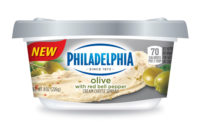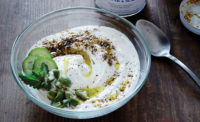Consumers are sweet on savory dairy products
Dairy processors are adding spicy peppers, herbs and other botanical ingredients to dairy foods. What’s going on? Our panel says consumers’ desire for more flavor, more stimulation and more experience is behind the trend.

Sargento Foods, Plymouth, Wis., has a new line of snacking cheeses in savory flavors. Among the options are a Monterey Jack with garlic and herbs, a Colby-Pepper Jack with habanero and jalapeno peppers, and a Cheddar seasoned with chipotle and barbecue flavors.

Blackberry-serrano pepper yogurt from Noosa Yoghurt, Bellvue, Colo., is available exclusively in Colorado.

Ice cream takes well to savory flavors. Seasonal flavors from Brooklyn, N.Y.-based processor OddFellows Ice Cream include buttermilk honey blueberry, Thai iced tea, apple cider and black pepper fig.

Savory flavors find their way into a handcrafted artisanal cheese line called La Bottega di BelGioioso from BelGioioso Cheese, Green Bay, Wis. Among the SKUs is an asiago with chili peppers.




If there’s a universal truth we can all count on, it’s that America’s three favorite ice-cream flavors will always be vanilla, chocolate and strawberry. Right? Wrong. Per the International Dairy Foods Association, Washington, D.C., our top three picks last year were vanilla, chocolate and butter pecan.
Okay, so that hardly heralds a revolution in consumer tastes. But look beyond this reigning trio and you will see an old guard being overthrown, or at least involuntarily entered into a power-sharing agreement with unruly upstarts. After all, IDFA’s own 2015 Innovative Ice Cream Flavor Competition (sponsored by Dairy Foods) featured entrants like chipotle chocolate and cherry, apple butter and biscuits and black cherry veggie. But these sound downright pedestrian next to the smoked salmon, cucumber vodka and kimchee profiles you might find at artisan ice creameries and hipster food co-ops across the country.
And ice cream isn’t alone. A wave of savory subversion is sweeping dairy, leaving previously sweet segments with something of an identity crisis. And though the initial effects might be disorienting, “the growing popularity of flavor profiles such as fermented, sour and bitter represents a tremendous opportunity within frozen desserts, yogurt — even cottage cheese,” said Alan Owen, director of marketing, sweet flavors for Sensient Flavors, Hoffman Estates, Ill.
If dairy developers can swerve from sweet to savory successfully, they’ll reap results worth the shakeup.
It’s a flavor thing
The stimulus for today’s savory swerve is no secret to Owen. He said flavor assortment is the key driver in ice cream and yogurt purchases.
Noted Meghan Patton of David Michael & Co., Philadelphia: “Over the past few years, we’ve definitely seen an uptick in savory flavors used in traditionally sweet dairy applications. And we’re no longer just talking about salted caramel.” Patton is the company’s associate marketing and consumer insights manager.
Still, vanilla is not going away. Not only is it “such an integral element in so many products,” said Paulette Lanzoff, technical director, Synergy Flavors, Inc., Wauconda, Ill., but it also “carries both a provenance and authenticity that are trending with shoppers; provided it’s real vanilla, of course.”
Ultimately, though, what’s driving consumers toward sweet-savory hybrids is a desire for more flavor, more stimulation and more experience.
“The underlying consumer motivation here is a heightened interest in experiencing and enjoying all the senses. New sounds, new imagery and especially new aromas and tastes are prime for experimentation,” explained French’s Flavor Ingredients Director of Culinary Trip Kadey. French’s is a division of French’s Food Co., Chester, N.J.
And consumers are ready to dive in.
Generation Experimentation
One set of consumers particularly poised to plunge are Millennials. As evidence, see Technomic’s “2015 Flavor Consumer Trend Report,” which found that 52% of Millennials would like more restaurants to offer foods that feature a combination of flavors — sentiments that translate from menus to supermarkets.
Gerrie Bouchard, the director of marketing for ADM/Eatem Foods, Vineland, N.J., has seen Millennials’ flavor-chasing in action.
“They want variety, and they want interesting combinations,” he said.
Their propensity toward grazing rather than dining on three square meals “lends itself perfectly to exploring for the next unique offering,” he added, while also blurring the boundaries of what constitutes “dessert.”
Thus far, urban-dwelling Millennials have made savory’s spread a largely metropolitan phenomenon.
But, said Patton, “As the food movement continues to expand, expect to see more unique flavor combinations on grocery store shelves across the United States.” Indie scoop shops and small-batch retail were ground zero for the trend, but “big brands are starting to experiment and embrace it,” too, she noted.
Cold feet
Some of them are, at least. “While we’ve seen some manufacturers of gelato and dips venture into the savory realm with spices like rosemary, basil and chilies, for the most part there’s been reluctance in the dairy industry to incorporate savory in innovation,” said Owen of Sensient Flavors.
Ana Gumabon, the R&D director for California Custom Fruits & Flavors, Irwindale, Calif., knows what he means. Her company has been testing sweet and savory profiles in frozen desserts and yogurts for over six years. Though she describes the flavor of an early ice cream concept that riffed on the California roll — avocado, cucumber, soy sauce — as “unexpectedly pleasant” and “well received” conceptually, the marketing group still “wasn’t sure if consumers were ready for sweet-savory ice cream,” she said.
Maybe that’s because industry is in no hurry to fix what’s not broken — like vanilla.
“But would vanilla purists be receptive to a vanilla clove, vanilla lemon thyme or a standard vanilla with a savory inclusion?” Owen asked. “I certainly think it’s worth exploring, even if launched as a seasonal flavor.”
To see the success of savory, look no further than the snack-bar aisle.
“Nuts, spices, salted meat and barbecue flavors are now common in that category and contribute significantly to its growth,” Owen noted. A similar pivot with ice cream “could generate some much-needed excitement in a category that’s been in decline for many years.”
Swerving sensibly
In fact, no sweet-savory swerve need be a stretch if it’s sensibly strategized. And flavor experts have plenty of advice for ensuring that it is.
“Stay simple and don’t over-flavor,” said Synergy Flavors’ Lanzoff. “Let the savory notes stay subtle and you’ll keep consumers interested.”
“We always test for taste compatibility,” Gumabon noted. Case in point: curry is an up-and-coming flavor in sweet-savory dairy, she said, but it doesn’t always play well with fruit profiles common to the category.
“And lately we’ve been combining fruits and vegetables. We’ve found that sometimes adding herbs or spices to fruit with vegetables hides the unpleasant earthy, leafy, bitter taste of some vegetables.”
Sweet vehicle
The consensus among flavor insiders is that ice cream will be the platform from which they’ll get the strongest launch.
“Ice cream is a relatively easy category to bring inventive flavors into. Even with vegetables, herbs or spices, it’s still sweet-forward and can satisfy a complex palate without going too far beyond comfort,” Patton said.
Applications Scientist Blake Webster of Flavorchem Corp., Downers Grove, Ill., noticed dill pickle profiles “in some very interesting applications,” including ice cream and sweetened beverages.
Bouchard sees chai-flavored ice creams “popping up across the country” and ascribes their success to how “the complexity of the spice arrangement allows for playful new twists, turns and truly innovative new products.”
Then consider yogurt’s strengths as a launching pad. Its culinary heritage spans the globe, Patton said. Gumabon noted that yogurt’s native acidity helps bring out savory flavors, while its sweetness level is not so high that it competes with savory notes.
Examples are on shelves already, like the blackberry-serrano flavor that Bellvue, Colo.-based Noosa introduced this year just to Colorado consumers. Chobani, New Berlin, N.Y., has two “heat meets sweet” varieties of its Flip yogurt: chipotle pineapple and sriracha mango.
Every year California Custom Fruits & Flavors tries to incorporate one sweet-savory profile into its new-products presentation, Gumabon said.
“Through the years, we’ve used bacon flavor and spices and seasonings such as curry, cardamom, anise, ginger, salt, pepper, balsamic, sriracha, habanero and other chilies. We’ve also used herbs such as cilantro, mint, basil and others.”
She keeps one bottom line in mind: “Subtlety, for most products, is key,” she said. “We try not to overpower the sweet taste. After all, it is still a sweet dessert.”
Looking for a reprint of this article?
From high-res PDFs to custom plaques, order your copy today!










